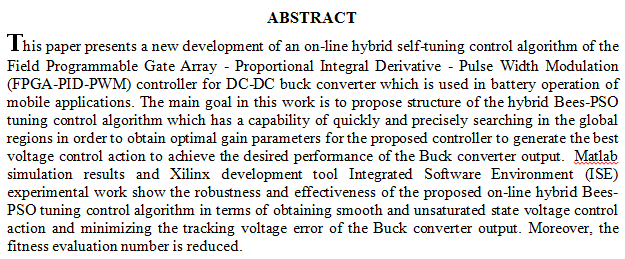
<span>We present the linearization of an ultra-wideband low noise amplifier (UWB-LNA) operating from 2GHz to 11GHz through combining two linearization methods. The used linearization techniques are the combination of post-distortion cancellation and derivative-superposition linearization methods. The linearized UWB-LNA shows an improved linearity (IIP3) of +12dBm, a minimum noise figure (NF<sub>min.</sub>) of 3.6dB, input and output insertion losses (S<sub>11</sub> and S<sub>22</sub>) below -9dB over the entire working bandwidth, midband gain of 6dB at 5.8GHz, and overall circuit power consumption of 24mW supplied from a 1.5V voltage source. Both UWB-LNA and linearized UWB-LNA designs are
... Show More (1)
(1)
The physical behavior for the energy distribution function (EDF) of the reactant particles depending upon the gases (fuel) temperature are completely described by a physical model covering the global formulas controlling the EDF profile. Results about the energy distribution for the reactant system indicate a standard EDF, in which it’s arrive a steady state form shape and intern lead to fix the optimum selected temperature.
A method has been demonstrated to synthesise effective zeolite membranes from existing crystals without a hydrothermal synthesis step.
 (28)
(28)
 (25)
(25)
AA Abbass, HL Hussein, WA Shukur, J Kaabi, R Tornai, Webology, 2022 Individual’s eye recognition is an important issue in applications such as security systems, credit card control and guilty identification. Using video images cause to destroy the limitation of fixed images and to be able to receive users’ image under any condition as well as doing the eye recognition. There are some challenges in these systems; changes of individual gestures, changes of light, face coverage, low quality of video images and changes of personal characteristics in each frame. There is a need for two phases in order to do the eye recognition using images; revelation and eye recognition which will use in the security systems to identify the persons. The mai
... Show More<p>The directing of a wheeled robot in an unknown moving environment with physical barriers is a difficult proposition. In particular, having an optimal or near-optimal path that avoids obstacles is a major challenge. In this paper, a modified neuro-controller mechanism is proposed for controlling the movement of an indoor mobile robot. The proposed mechanism is based on the design of a modified Elman neural network (MENN) with an effective element aware gate (MEEG) as the neuro-controller. This controller is updated to overcome the rigid and dynamic barriers in the indoor area. The proposed controller is implemented with a mobile robot known as Khepera IV in a practical manner. The practical results demonstrate that the propo
... Show More (3)
(3)
In this paper, the finite element method is used to study the dynamic behavior of the damaged rotating composite blade. Three dimensional, finite element programs were developed using a nine node laminated shell as a discretization element for the blade structure (the same element type is used for damaged and non-damaged structure). In this analysis the initial stress effect (geometric stiffness) and other rotational effects except the carioles acceleration effect are included. The investigation covers the effect speed of rotation, aspect ratio, skew angle, pre-twist angle, radius to length, layer lamination and fiber orientation of composite blade. After modeling a non-damaged rotating composite blade, the work procedure was to ap
... Show MoreThe growth curves of the children are the most commonly used tools to assess the general welfare of society. Particularity child being one of the pillars to develop society; through these tools, we can path a child's growth physiology. The Centile line is of the important tools to build these curves, which give an accurate interpretation of the information society, also respond with illustration variable age. To build standard growth curves for BMI, we use BMI as an index. LMSP method used for finding the Centile line which depends on four curves represents Median, Coefficient of Variation, Skews, and Kurtosis. These can be obtained by modeling four parameters as nonparametric Smoothing functions for the illustration variable. Ma
... Show MoreA few examinations have endeavored to assess a definitive shear quality of a fiber fortified polymer (FRP)- strengthened solid shallow shafts. Be that as it may, need data announced for examining the solid profound pillars strengthened with FRP bars. The majority of these investigations don't think about the blend of the rigidity of both FRP support and cement. This examination builds up a basic swagger adequacy factor model to evaluate the referenced issue. Two sorts of disappointment modes; concrete part and pulverizing disappointment modes were examined. Protection from corner to corner part is chiefly given by the longitudinal FRP support, steel shear fortification, and cement rigidity. The proposed model has been confirmed util
... Show More (2)
(2)
 (14)
(14)
We propose a new object tracking model for two degrees of freedom mechanism. Our model uses a reverse projection from a camera plane to a world plane. Here, the model takes advantage of optic flow technique by re-projecting the flow vectors from the image space into world space. A pan-tilt (PT) mounting system is used to verify the performance of our model and maintain the tracked object within a region of interest (ROI). This system contains two servo motors to enable a webcam rotating along PT axes. The PT rotation angles are estimated based on a rigid transformation of the the optic flow vectors in which an idealized translation matrix followed by two rotational matrices around PT axes are used. Our model was tested and evaluated
... Show More (8)
(8)
 (4)
(4)
